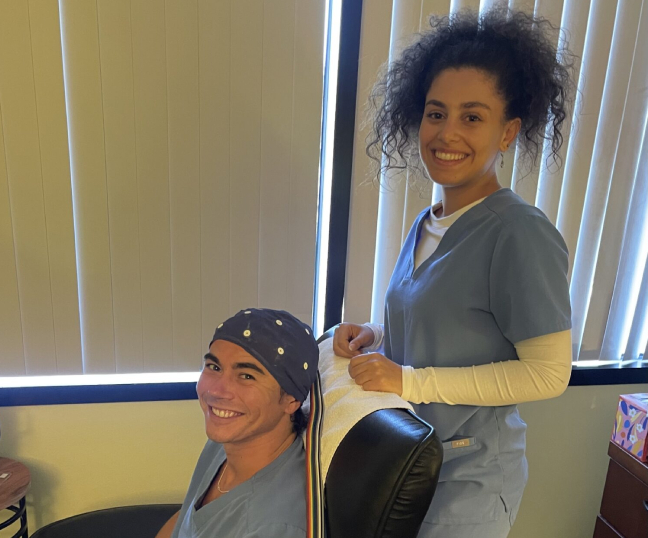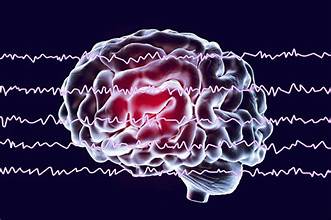Brain Mapping (QEEG)
The QEEG report is like a snapshot of your brain’s electrical activity, taken by placing a cap with electrodes on your head. This data is compared to a database of healthy brains of your age. Our equipment then creates a visual map of your brain, highlighting areas that might be too active or not active enough. We call this map a Brain Map, and it gives us a detailed overview of your brain’s condition. We use this, along with information you provide, to create a personalized training plan.
The process is painless and noninvasive—just a cap on your scalp with 20 electrodes. Gel is applied to these electrodes, and they capture tiny electrical signals produced by your brain, shown as squiggles or brainwaves. You’ll relax with your eyes closed for 10 minutes and then open for another 10 while we record these brainwaves. Afterward, we analyze the raw data.

The brainwaves go through filters, like specialized software, breaking them into components and bandwidths such as Delta, Theta, Alpha, Beta, and Gamma. By comparing your data to databases from hundreds of others, we can see where your brain differs from the norm—whether it’s an improvement or a decline. The analysis goes beyond individual brainwaves, considering their relationships, symmetry, and stability, pinpointing areas where your brain might be signaling problems, leading to observable symptoms and behaviors.
This assessment forms one of the basis for creating a plan to guide your future training efforts.
How The Process Unfolds
- Initial visit and intake, encompassing 20 minutes of EEG recording: During this stage, we record the “raw data,” represented by the brainwaves. Subsequently, we eliminate any “artifact,” such as eye movements or excessive muscle tension. Please expect to be here for an hour.
- EEG Analysis and Report Generation: The amplitude, frequency, and interrelationships among different areas of the cortex are scrutinized and statistically measured by specialized software. The findings are then presented in the form of “brain maps,” with your EEG being compared to a reference database of other EEGs.
- Follow-up report of findings session, along with treatment recommendations from Dr. Kakaiya. The QEEG serves as one of the foundations for creating a personalized and data-driven protocol. This protocol serves as a baseline of your brain and a tailored blueprint for training your brain.
- Dr. Kakaiya also conducts a thorough clinical evaluation to add to the brain mapping results.
How To Prepare For The Day Of Your Test
- Refrain from consuming caffeinated beverages 15 hours before the test.
- Avoid alcoholic beverages and smoking marijuana for 2 days before the test.
- Ensure that your hair and scalp are completely dry.
- Shampoo your hair, but skip the use of conditioner.
- Abstain from applying hair products like hair spray, gel, or mousse.
- Remove all hair accessories, such as extensions, hairpieces, bobby pins, hair ties, earrings, etc.
- Refrain from intense workouts or jogging immediately before the test (light activity is acceptable).
- Avoid taking any over-the-counter medication or supplements for two days before the test. Please be sure to take your prescription medications per schedule.
- Avoid staying up late the night before the test. We want you to be well rested.
- If you wear contact lenses, be prepared to remove them during your session (these can cause excess eye blinks/movements). Bring any contact lens solution and containers that you need if you remove your contacts.
- Go to the restroom immediately before your session. Once you are hooked up for your recording it is difficult to unhook you so that you can use the restroom.
- Turn off your cell phone and any other electronic devices during your recording. It is best if you leave your phone and any other electronic devices turned off.
- Bring a small cap (baseball cap) to wear home (hair will be messy from the gel and cap).
- Do not come in drowsy.
- Do not come in hungry.
- Wear comfortable clothes, for optimal relaxation.
- Take responsibility for making your Brain Mapping session a success. Your technician will make every effort to help you obtain the best recording possible. However, in some cases, the EEG may still need to be rerecorded or rescheduled.
- Repeating a recording due to excess artifact (eye blinks/movement/muscle tension/drowsiness).
- Repeating a recording due to a lack of willingness or ability to perform the basics of the recording (such as when a child is unable to leave the electrodes or recording cap in place).
- Failing to show up for your scheduled recording appointment without canceling.
- Rescheduling a recording due to your late arrival for your recording appointment.
